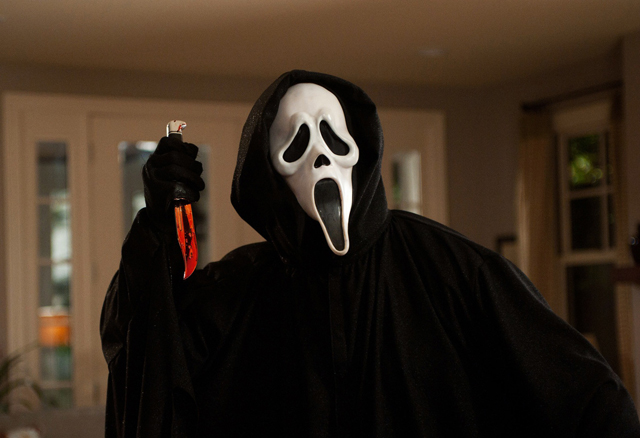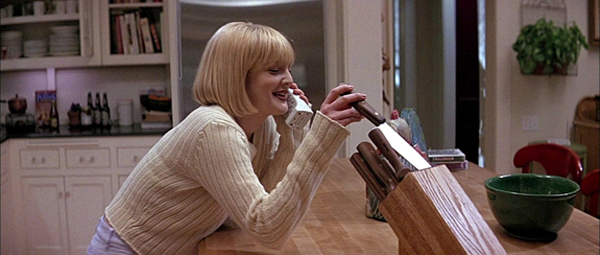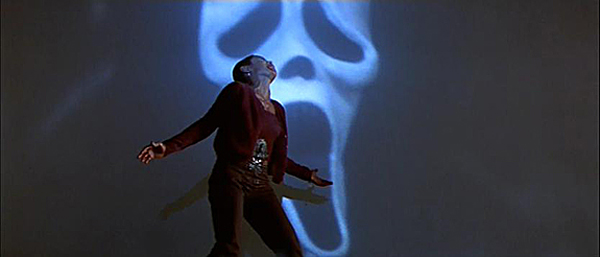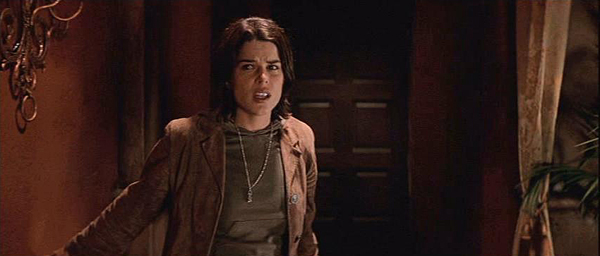With Halloween looming just around the corner, I thought it would be appropriate to highlight another horror franchise in this series, and examine how it progressed over time, and whether or not it stayed true to it’s original concept. What I decided to do this week was honor the the recently departed horror icon Wes Craven with a spotlight on one of his most popular titles, that being the Scream franchise. Wes Craven’s movies may not be to everyone’s tastes, and I wouldn’t exactly consider myself a huge fan of his either, but there’s no denying that he is one of the kings of the horror genre; probably without equal. No other horror film director was as prolific nor as resilient. He’s as synonymous to the horror genre as John Ford is to Westerns, and though many of his movies aren’t what I would consider masterpieces, you can’t help but admire him for becoming a master of his craft. Horror as we know it today owes a lot to the film-making style of Wes Craven. Craven brought gore into the mainstream of the horror genre. What Dario Argento pioneered in the art house independent market, Craven made it work in Hollywood. He began with low budget schlock-fests like The Last House on the Left (1972) and The Hills Have Eyes (1977) before making his big bloody splash in the 80’s with A Nightmare on Elm Street (1984), the movie that turned Craven into a household name and introduced the world to one of Horror’s most iconic monsters; Freddy Kruger. Over time, Wes Craven had trouble living up to the legacy of Elm Street, but that was until he reinvented himself again in the late 90’s with a new horror movie that turned the genre on it’s head, in more ways than one.
When Scream premiered in 1996, the horror genre had largely lost a lot of it’s luster, in no small part because few if any horror movies ever felt original. Most horror franchises usually would start strong and then later peter out the longer they went on. The sequelizing of these movies became monotonous to audiences who saw the same cliched things happening over and over again without ever getting better. Wes Craven, to his credit, was not only a contributor to the horror genre, but also an appreciator as well, and over time he was compelled to address the declining state of the genre. One thing that he did observe in the mid nineties was the rise of movie savvy audiences who were more keenly aware of all the different tropes that make up a horror movie, given that many of them had grown up with them in their youth. He also observed the way that some horror movies over time would develop cult followings, and how that would in turn drive the success rates of some franchises. Though it was well before the rise of the internet, which would compound this phenomenon to unprecedented levels, Wes Craven did see a new kind of horror movie culture that had emerged and he saw in it a new kind of subculture worth exploiting for a horror movie. He found the voice he needed to tap into this newer, younger audience with screenwriter and Dawson’s Creek creator Kevin Williamson and the end result became a movie that not only dissected horror cliches, but also revitalized them for a new generation. It was horror for the MTV generation, and for better or worse, Wes Craven had changed the genre once again. For this article, I will be looking at the Scream series as a whole and see how it fared from the groundbreaking first film all the the way through it’s less effective follow-ups, and how they reflected the back on the career of it’s creator as well. Fair warning; some spoilers ahead.
SCREAM (1996)
This is the one that started it all, and is in-arguably one of the most influential horror movies of all time. Wes Craven’s movie stands out for a number of reasons; it modernized the genre, it was self-aware in ways that most horror movies weren’t, and it introduced a new iconic monster to the genre that would become quite literally the face of a franchise; Ghostface. The movie starts off with bang in it’s opening prologue, and talk about a movie wanting to make a statement right off the bat. In it, a lonely girl named Casey (Drew Barrymore) is confronted over the phone by a mysterious stranger who asks her about her favorite scary movies. Playful at first, the conversation quickly turns menacing as Casey learns she’s not alone and that whoever is on the other line is out to get her. Soon, she is chased down by a person in a black robe wearing a ghost mask and wielding a knife. Suffice to say, she doesn’t make it. It’s an effectively gruesome and tense scene that sets the tone perfectly, both with the horror elements and also with the self-aware critiquing of the genre itself. The rest of the movie introduces us to Sidney Prescott (Neve Campbell), who will inevitably be the focus of all the horror tropes going forward in this movie along with the remainder of the franchise. She’s accompanied along the way by Deputy Dewey (David Arquette), who’s trying to find a link between all the murders happening in town by the “Ghostface” killer, as well as by reporter Gale Weathers (Courtney Cox) who is after a story to help boost her career. Over time, Sidney learns that she’s target number one on the killer’s hit list, and that even her friends like boyfriend Billy (Skeet Ulrich), horror film nerd Randy (Jamie Kennedy), and class jock Stuart (Matthew Lillard) might be the killer behind the mask.
Overall, I would have to say that this movie is easier to respect than to admire. For one thing, I do like the way that Wes Craven turns the horror genre on it’s head by making us aware of the horror movie cliches before they happen, helping to make this movie both frightening as well as refreshingly silly. One of the best things about Craven’s style is the way that he doesn’t take himself too seriously. He goes for the ridiculous and absurd constantly in his movies, which was a staple of Nightmare on Elm Street. The same thing happens here too whenever necessary, particularly in some of the more gruesome killings, like Rose McGowan’s character getting crushed in a retractable garage door. But, where the movie falters is in the plot itself. However clever the death scenes may be, the movie sadly gets bogged down in a generic thriller plot involving Sidney and the mystery around her family’s dark history. Of course, horror movies aren’t renowned for their intricate plots, and using a cliched story may be by design on Craven’s part, but it still acts as an inhibitor to the overall movie. In addition, time hasn’t been kind to this movie either. What seemed groundbreaking back then feels very dated today, probably because the movie is so steeped in it’s time period. It’s a 90’s movie down to it’s core, which may give it some nostalgia value today, but probably not positive overall. But, at the same time, whatever faults it has as a story doesn’t diminish it’s impact. This was a highly influential movie that really shaped the language of horror for a decade thereafter. There were so many copycat horror films that tried to do the same thing in the following years, but never quite made it. For me, it’s a respectable benchmark in the genre, but one that never did rise up to the level set by it’s brilliant opening scene. But, the question remained; could Wes Craven ever rise to that level again?
SCREAM 2 (1997)
Released right on the heels of the first movie, with little over a year in between, Scream 2 picked up right where the last film left off. And, remarkably that quick turnaround for Wes Craven yielded a superior product. This, to me is the best film in the franchise, because it fixes most of the story problems of the first movie and it plays upon the self aware aspects of the genre in an even more pointed way. Taking Sidney into college provides the film’s subtext with even more ammunition, as this movie gets to poke fun at the way that younger audiences respond to horror movies at the time. Since the murders of the first movie, Sidney’s has turned into a mild celebrity, with her ordeal having been adapted into a movie itself. As a result, she is hounded by the spotlight, having to re-confront the reality of her worst life experience constantly. This becomes even worse when it seems that a copycat killer is on the loose, bringing “Ghostface” back from the dead. Given the first movie’s phenomenal success, the meta narrative actually manages to self-examine itself, making the observations by the characters feel all the more resonant and the use of the cliches a lot smarter. And it doesn’t address horror movie cliches only, like the seemingly indestructible killer or the predictably timed death of two lovers after they’ve had sex. It also critiques sequel cliches as well, like how the stakes and scale are raised but the same results still happen. And the way that the first Scream influenced so much of horror in it’s wake, including turning Ghostface into an instant icon, helps Wes Craven address the cult like following that horror movies can have in a much more effective way here, given that it actually happened it to this franchise in reality.
Like what most great sequels do, it ups the ante without having to rehash old ideas. This is evident right from the opening scene, which manages to both surpass the first movie’s opening while at the same time poking fun at it. It involves a couple (played by Omar Epps and Jada Pinkett Smith) going to a theater to see the film adaptation of the murders in the first movie. The audience around them proves to be full of rabid fans, all coming to the theater in the “Ghostface” costume. Though most of crowd is friendly, if a bit rowdy, the couple soon learns too late that a real killer is among them. This leads to a chilling revelation as the couple are slaughtered there in the theater as the movie plays along with a tongue-in-cheek recreation of the first movie’s opening scene. It’s a brilliant juxtaposition that represents the best of Wes Craven’s horror movie tropes; his mercilessly gruesome vision and his macabre sense of humor. Thankfully, the remainder of the movie lives up to the opening and the two sides of Craven’s style help to elevate the story rather than get in the way. Even with all the horror movie cliches being lampooned, it still manages to offer up a few surprises. Like I said, spoilers coming, and one of the film’s more pleasant surprises is the revelation of the murderer, who turns out to be the mother of Billy, the original film’s killer, played here effectively by Laurie Metcalf. It’s a nice nod to another horror franchise, as this movie uses the Mrs. Voorhies twist of Friday the 13th (1980) to great effect and makes the murders in this movie revenge killings, which is a logical next step to go with for a sequel. Overall, Scream 2 surpasses it’s predecessor in every way and shows that Wes Craven had enough good ideas for more than one movie in this franchise.
SCREAM 3 (2000)
Unfortunately, this is where all the good ideas ran out. Naturally, the success of the first two movies led to a third film, but none of what made the other two movies effective translated over. I think one big reason for this is the loss of Kevin Williamson as screenwriter. Instead, Wes Craven had this sequel written by newcomer Ehren Kruger, who has since gone on to be the writer behind the Michael Bay Transformer movies. That should give you an indication of the intelligence level of this movie. While not one of the worst horror movies I’ve ever seen (being largely saved by Wes Craven’s stylistic direction), this movie is still remarkably stupid. The self-aware humor that defined so much of the first two movies is clumsily handled here. There’s even an awful deus ex machina element where Jamie Kennedy’s Randy (who was killed off in the previous movie) somehow had left a tape for the main characters to find where he details exactly how a trilogy capper works, giving them insight into how they should respond to the new set of murders happening around them. Also, this movie has one of the most preposterous twist endings that I’ve ever seen. Even Scooby Doo and his gang would laugh at how stupid a choice the main killer ends up being. The movie’s one saving grace is the addition of some genuinely funny comedic actors like Parker Posey and Patrick Warburton into the mix, both of whom are sadly underused before they are inevitably killed off. Parker Posey, in particular, actually elevates the material here, making what could have been a horribly written obnoxious character into a welcome comic relief. It seems like all those years working in Christopher Guest movies paid off for her improv skills. Her character gives me the feeling that Wes Craven wanted to go into a more comical direction with this movie, but somewhere down the line he lost control of the tone and it ended up not working as well as he hoped. Sadly, with a dumb downed plot and a lazy screenplay, this was a big step backwards for the franchise and one that put it on ice for over a decade.
SCREAM 4 (2011)
The decade long gap in between Scream 3 and Scream 4 proved to be a transition period for the horror film genre. The result of the first Scream‘s success proved to be an era of a lot of failed wannabes, all trying to match Scream’s more crass and self-aware style. Instead of originality taking hold, we got a lot of ludicrous horror movies that tried to be too clever for their own good. This was the era of the PG-13 horror flick, which were aimed more at the teenage set, which Scream so effectively connected with despite it’s R-rating. And of course, PG-13 gore is not at all scary. But, thankfully at this same time, fresh new ideas were made in response to the watered down Scream clones with R-rated fare like Saw (2004). There were also new horror filmmakers emerging like Rob Zombie (The Devil’s Rejects) and James Wan (The Conjuring) who helped to bring credibility back to the genre as well. During this time, Wes Craven had developed his name into a brand, which had it’s good points as well as it’s bad. The good side was that he was able to lend his name to projects that normally would’ve gone under the radar, like his 2005 thriller Red Eye, but the bad side was the standard to which he had to live up to. Thus, after years away from the genre he helped to reshape, Wes Craven delivered another Scream sequel, and quickly proved that this was a franchise way beyond salvaging. It’s not as stupid as Scream 3 (though some moments come close like a character telling the “Ghostface” killer that he can’t die because he’s gay and that it’s against the genre rules), but it commits an even worse crime of just being boring. Mainstays Neve Campbell, Courtney Cox and David Arquette return, but they are sidelined by a new group of teenage victims, all of whom are bland genre archetypes. In a sense, Scream 4 became just another wannabe, which is sad given that this came from the series’ original creator in what turned out to be his swan song as a director. It’s too bad that a decade of waiting didn’t yield anything more for this franchise than just a cash in for the studio that made it.
Overall, the Scream franchise may be a clunky and inconsistent addition to the horror genre, but at the same time you can’t help but respect it. It did modernize the genre at a time when it was desperately needed and it also allowed audiences in on the joke as it gave away some of it’s tricks. One only wishes that it had been more effective at getting it’s point across with each movie. The only time where I felt that the franchise got the formula down perfectly was in Scream 2, a movie that was much better than it had any right to be. The first Scream is a mixed bag, but it’s high points far outweigh the bad, and it’s impact is still something to respect, even if it did spawn some rather lame results. Sadly, Wes Craven had a hard time living up to that legacy, but even still, it’s admirable how he managed to rewrite the rules of the genre consistently throughout his career. Scream may seem dated today, but you can honestly say that about any horror film made by Wes Craven. He liked to have his movies reflect the era that they existed in and that’s a great sign of an evolving filmmaker. He embraced the new attitudes and tastes of his audiences and rewarded them with the things that they wanted, even if he wasn’t always successful at it. And what made him so effective in the horror genre was his ability to make effective monsters. Ghostface is rightfully as iconic as other horror mainstays like Jason Voorhies and Freddy Kruger, and one of the scariest aspects of this killer is that it’s iconic nature is what fuels it’s resurgence throughout every movie, living on a mask for new killers. Unlike it’s peers, Ghostface lives on because someone always picks up the mantle and dons the mask again, keeping the cycle going. It’s a movie monster built out of legend rather than mysticism, making it all too realistic and as a result, even more terrifying. That’s the great legacy of Wes Craven’s Scream franchise; connecting the horror genre with the modern world and showing how the subculture of horror can even bring out monsters of it’s own. We live in a modern society today where horror is not so imaginative and copycat killings are sadly all too real in our society. In the end, Wes Craven gave horror a new face, and it was one that was horrifyingly human.




